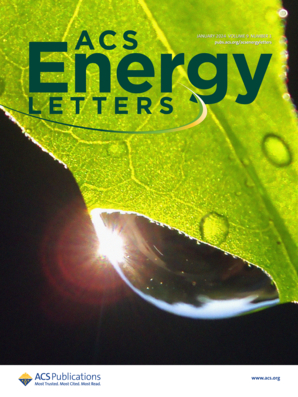Electrocatalytic Reactive Capture of NO from O2-Containing Simulated Flue Gas Using Highly O2-Resistant Fe2+-(salen-SO3) for NH3 Synthesis
IF 19.3
1区 材料科学
Q1 CHEMISTRY, PHYSICAL
引用次数: 0
Abstract
Efficient removal of nitric oxide (NO) from flue gases remains a significant environmental challenge due to its low concentration, poor water solubility, and the presence of oxygen, which deactivates traditional NO absorbents such as Fe2+-EDTA. Herein, we present an electrochemistry-based reactive NO capture system using SO3-functionalized Fe2+-salen as an NO absorbent with outstanding oxygen resistance. The unique tetracoordinate structure of the salen-SO3 ligand reduces the electron density at the Fe2+ center, preventing its oxidation to Fe3+ under air exposure. Coupled with highly porous NiMo electrocatalysts, the system achieves an NH3 production rate of 2.0 mmol h–1 cm–2geo with 97% Faraday efficiency under 100% NO. This continuous NO capture and conversion into NH3 was maintained under air-exposed conditions at 60% of the performance level under 100% NO, with stability over 160 h. Mechanistic studies reveal that Fe2+ is the critical active site for NO reduction and elucidate complete reaction pathways for NH3 synthesis.

高抗氧化性Fe2+-(salen-SO3)电催化捕获含o2模拟烟气中NO合成NH3
由于烟气中一氧化氮(NO)的浓度低、水溶性差以及氧的存在,使传统的NO吸附剂(如Fe2+-EDTA)失效,因此有效去除一氧化氮(NO)仍然是一项重大的环境挑战。在此,我们提出了一种基于电化学的反应性NO捕获系统,该系统使用so3功能化的Fe2+-salen作为NO吸附剂,具有出色的耐氧性。salen-SO3配体独特的四配位结构降低了Fe2+中心的电子密度,防止其在空气暴露下氧化为Fe3+。在100% NO条件下,该体系的NH3产率为2.0 mmol h-1 cm-2geo,法拉第效率为97%。在100% NO条件下,这种连续的NO捕获和转化为NH3的性能在空气暴露条件下保持在60%的水平,并在160 h以上保持稳定性。机制研究表明,Fe2+是NO还原的关键活性位点,并阐明了NH3合成的完整反应途径。
本文章由计算机程序翻译,如有差异,请以英文原文为准。
求助全文
约1分钟内获得全文
求助全文
来源期刊

ACS Energy Letters
Energy-Renewable Energy, Sustainability and the Environment
CiteScore
31.20
自引率
5.00%
发文量
469
审稿时长
1 months
期刊介绍:
ACS Energy Letters is a monthly journal that publishes papers reporting new scientific advances in energy research. The journal focuses on topics that are of interest to scientists working in the fundamental and applied sciences. Rapid publication is a central criterion for acceptance, and the journal is known for its quick publication times, with an average of 4-6 weeks from submission to web publication in As Soon As Publishable format.
ACS Energy Letters is ranked as the number one journal in the Web of Science Electrochemistry category. It also ranks within the top 10 journals for Physical Chemistry, Energy & Fuels, and Nanoscience & Nanotechnology.
The journal offers several types of articles, including Letters, Energy Express, Perspectives, Reviews, Editorials, Viewpoints and Energy Focus. Additionally, authors have the option to submit videos that summarize or support the information presented in a Perspective or Review article, which can be highlighted on the journal's website. ACS Energy Letters is abstracted and indexed in Chemical Abstracts Service/SciFinder, EBSCO-summon, PubMed, Web of Science, Scopus and Portico.
 求助内容:
求助内容: 应助结果提醒方式:
应助结果提醒方式:


